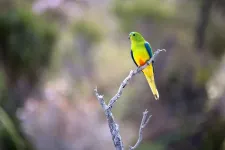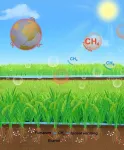(Press-News.org) A new study has estimated it would cost $15.6 billion per year for 30 years to prevent extinction for 99 of Australia’s priority species.
The research, led by Griffith University’s Centre for Planetary Health and Food Security with WWF-Australia and the University of Queensland, highlights the urgent need for increased funding to combat threats such as habitat destruction, invasive species and climate change.
Australia has already lost more than 100 endemic species in the past three centuries, placing it at the forefront of the global extinction crisis.
The Australian Government has made a commitment to reverse the decline of 110 priority species.
The research looked at the cost for preventing extinction for 99 of these species.
Lead author Dr Michelle Ward said while the annual $15.6 billion could prevent the imminent extinction of many threatened species, there were some species, including many frogs, which were found to be non-recoverable, largely due to climate change.
“Species such as Mountain-top Nursery Frog and Swan Galaxias were found to be of real concern and need active ex-situ conservation,” Dr Ward said.
“The cost to reverse the decline of priority species and undo damage done by habitat loss, disease and other threats was estimated at $103.7 billion annually, while getting them off the threatened list entirely would require $157.7 billion per year.”
Dr Romola Stewart, a co-author and WWF-Australia’s Head of Evaluation and Science, said the paper highlighted the true cost of ineffective nature laws and inadequate species funding.
"Australia’s ever-growing list of threatened species is a direct result of decades of under spending," she said.
“Turning this tragedy around will take a dramatic increase in action and investment.
“This is achievable for a wealthy nation like Australia.
"If we fail to put our wildlife and wild places on a path to recovery, our economy and environment will suffer, and we will see more species silently slide towards extinction."
The study also highlighted the broader benefits of conservation investment, including the co-benefits to 43 per cent of all other threatened species and improved ecosystem services essential for human wellbeing.
"The natural world is undergoing profound change," Dr Ward said.
“Biodiversity loss and ecosystems collapse is ranked by the World Economic Forum as the second most significant global risk over the next decade, with 50 per cent of the global economy dependent on nature.
“There is merit in the Australian Government’s commitment, but urgent action is needed.”
The study ‘The estimated cost of preventing extinction and progressing recovery for Australia’s priority threatened species’ has been published in the Proceedings of the National Academy of Sciences (PNAS).
Images available for download here.
ENDS
END
The cost of preventing extinction of Australia’s priority species
A new study has estimated it would cost $15.6 billion per year for 30 years to prevent extinction for 99 of Australia’s priority species.
2025-02-03
ELSE PRESS RELEASES FROM THIS DATE:
JMIR Publications announces new CEO
2025-02-03
(Toronto, February 3, 2025) JMIR Publications, the leading open access publisher in digital health and open science, announced today that Sean Jeong has been appointed as its new chief executive officer (CEO), effective January 23, 2025. Dr Gunther Eysenbach, founder of JMIR Publications, will be stepping down as CEO after over two decades of transformative leadership to focus on new opportunities for innovation in academic publishing, including artificial intelligence (AI)–driven solutions and the advancement of Plan P. He will continue to serve as the editor in chief of the Journal of Medical ...
NCSA awards 17 students Fiddler Innovation Fellowships
2025-02-03
The National Center for Supercomputing Applications awarded Fiddler Innovation Fellowships to 17 University of Illinois Urbana-Champaign and NCSA graduate students in a ceremony January 28 honoring the outstanding achievements and interdisciplinary contributions to NCSA programs Students Pushing Innovation (SPIN) and Design for America during the 2023-24 academic year.
The awards are part of a $2 million endowment from Jerry Fiddler and Melissa Alden to Illinois in support of student ...
How prenatal alcohol exposure affects behavior into adulthood
2025-02-03
Fetal alcohol spectrum disorders (FASD), characterized by symptoms of cognitive decline, such as worsened memory and impaired decision-making, are alarmingly prevalent globally. In a new study in JNeurosci led by Amy Griffin at the University of Delaware, researchers used rats to find brain circuits that may contribute to the cognitive issues that FASD patients experience, with the end goal of informing treatment strategies. Brain regions linked with working memory and decision-making were damaged in baby rats following exposure to alcohol during the age equivalent of the third trimester ...
Does the neuron know the electrode is there?
2025-02-03
Overview:
A research group from the Institute for Research on Next-generation Semiconductor and Sensing Science (IRES²) at Toyohashi University of Technology developed an innovative in vivo electrophysiological neural recording technology that minimizes neuronal death and allows stable recordings for over a year.
This breakthrough involves a 5-µm-diameter microneedle electrode fabricated on a flexible film using silicon-growth technology. Through experiments using mice, the team demonstrated significantly reduced neuronal death and stable neuronal activity recordings compared with traditional electrode technologies, overcoming long-standing challenges in neural recording.
Details:
Long-term ...
Vilcek Foundation celebrates immigrant scientists with $250,000 in prizes
2025-02-03
New York, NY, February 3, 2025 — The Vilcek Foundation has announced $250,000 in awards recognizing immigrant scientists. The 2025 Vilcek Foundation Prizes in Biomedical Science are bestowed as part of the foundation’s annual prizes program in support of its mission.
The Vilcek Foundation Prizes in Biomedical Science are a tribute to Vilcek Foundation co-founder Jan Vilcek, biomedical scientist and philanthropist. Born in Slovakia, Vilcek excelled as a researcher and immunologist, publishing his first single-author paper in Nature at 26. In 1965, with his wife, Marica, he immigrated to the United States ...
Age and sex differences in efficacy of treatments for type 2 diabetes
2025-02-03
About The Study: This systematic review and network meta-analysis of 601 eligible trials found that sodium-glucose cotransporter 2 (SGLT2) inhibitors and glucagon-like peptide-1 (GLP-1 receptor agonists were associated with lower risk of major adverse cardiovascular events. Analysis of age × treatment interactions suggested that SGLT2 inhibitors were more cardioprotective in older than in younger people despite smaller reductions in hemoglobin A1c; GLP-1 receptor agonists were more cardioprotective in younger people.
Corresponding Author: To contact the corresponding author, Peter Hanlon, PhD, email peter.hanlon@glasgow.ac.uk.
To access the ...
Octopuses have some of the oldest known sex chromosomes
2025-02-03
The octopus just revealed another one of its secrets: what determines its sex.
University of Oregon researchers have identified a sex chromosome in the California two-spot octopus. This chromosome has likely been around for 480 million years, since before octopuses split apart from the nautilus on the evolutionary tree. That makes it one of the oldest known animal sex chromosomes.
The finding also is evidence that octopuses and other cephalopods, a class of sea animals that includes squid and nautiluses, do use chromosomes to determine their sex, answering a longstanding mystery among biologists.
“Cephalopods are already such interesting creatures, ...
High-yield rice breed emits up to 70% less methane
2025-02-03
Rice cultivation is responsible for around 12% of global methane emissions, and these emissions are expected to increase with global warming and as the human population continues to grow. Now, scientists have identified chemical compounds released by rice roots that determine how much methane the plants emit. On February 3 in the Cell Press journal Molecular Plant, they report that this information enabled them to breed a new strain of rice that emits up to 70% less methane.
“This study shows that you can have low methane and ...
Long COVID prevalence and associated activity limitation in US children
2025-02-03
About The Study: In 2023, post–COVID condition (PCC) continued to affect U.S. children at similar levels as 2022 and to have similar sociodemographic patterns. The large proportion of children experiencing PCC with any activity limitation highlights the need to examine the severity of activity limitation, functional outcomes, and days lost from school.
Corresponding Author: To contact the corresponding author, Nicole D. Ford, PhD, MPH, email yex9@cdc.gov.
To access the embargoed study: Visit our For The Media website ...
Intersection of race and rurality with health care–associated infections and subsequent outcomes
2025-02-03
About The Study: This cohort study of hospitalized adults identified inequities related to race and rurality in health care–associated infections (HAIs) and adverse outcomes from HAIs. These findings suggest that factors such as structural racism and disinvestment in rural communities may be associated with individual HAI risk and post-HAI outcomes. Future work to further understand the reasons underpinning these disparities and methods to address structural factors through policy and process changes are critical to ...
LAST 30 PRESS RELEASES:
Clearing the brain of aging cells could aid epilepsy and reduce seizures
Brain injuries linked with potential risk of suicide, new study finds
New technique lights up where drugs go in the body, cell by cell
New study finds movement of fishing fleets can reveal shifts in marine ecosystems
Embargoed: New evidence points to potential treatment for vascular dementia
Study uncovers disrupted brain balance in alcohol dependence
Working in groups can help Republicans and Democrats agree on controversial content moderation online
Structural findings reveal how distinct GPCR ligands create different levels of activation
Anything-goes “anyons” may be at the root of surprising quantum experiments
UC review: Maximizing workplace opportunity for veterans
From generation to complex control: Metasurfaces make perfect vortex beams "within reach"
Thin-film lithium niobate-based detector: recent advances and perspectives
Exploring why some people may tend to persistently make bad choices
How cells balance their protein levels
Nirsevimab vs RSVpreF vaccine for RSV–related hospitalization in newborns
Effectiveness and impact of maternal RSV immunization and nirsevimab on medically attended RSV in US children
AI gives scientists a boost, but at the cost of too many mediocre papers
Next-generation vision model maps tree growth at sub-meter precision
Genes aren’t destiny for inherited blindness, study shows
MIT study: High-fat diets make liver cells more likely to become cancerous
Exposure to multiple fine particulate matter components and incident depression in the US Medicare population
Risk of burdensome health care spending over time in the US
Nirsevimab against hospitalizations and emergency department visits for lower respiratory tract infection in infants
New microfluidics technology enables highly uniform DNA condensate formation
A new strategy for immune tolerance
Super Mario Bros. help fight burnout: New study links classic games to boosted happiness
Deepest gas hydrate cold seep ever discovered in the arctic: International research team unveils Freya Hydrate Mounds at 3,640 m depth.
Integrating light and structure: Smarter mapping for fragile wetland ecosystems
ACA-SIM: A robust way to decode satellite signals over complex waters
Probiotics can restore gut microbiome in breastfed infants
[Press-News.org] The cost of preventing extinction of Australia’s priority speciesA new study has estimated it would cost $15.6 billion per year for 30 years to prevent extinction for 99 of Australia’s priority species.





